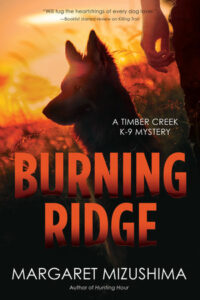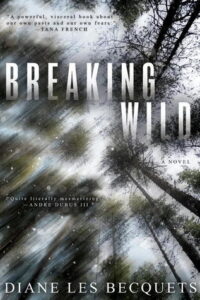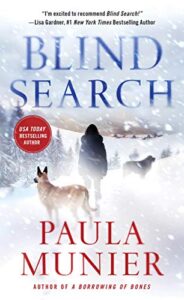Man versus nature. It’s one of the core external conflicts of storytelling: pitting a person or persons against the forces of nature, be it a hurricane, blizzard, or killing drought. In some thrillers, this may be the main conflict; in many, it comprises a secondary conflict to the larger clash of man versus man. Often, the wilderness plays a part in this struggle, adding an extra layer of isolation, an unfamiliar stressor for many in a society interconnected by constant and instantaneous communication. A wilderness can provide the most beautiful of landscapes that beckon exploration, but that beauty can hide the most treacherous of dangers—elemental nature, exposing who we are without technology or many of the common crutches of everyday urban life.
Many thrillers take advantage of this situation as a way to expose a character’s true personality because, when survival is at stake, it can be the truest revelation of human nature. But when those entering the wilderness do so with a canine at their side, they find they have a significant advantage over the inherent challenges of the environment.
The remote beauty of the wilderness can be a double-edged sword. I set Still Waters deep in the isolation of Minnesota’s northern Boundary Waters Canoe Area for this precise reason. Not only is it ideal for the water search and recovery training scheduled for eight search-and-rescue dog and handler teams from across the country, but it’s an area so remote, you can only enter by vehicle from a scant few locations; otherwise, portage is the main method of travel. As a result, when one on of the handlers is found murdered at the bottom of Lake Insula, and anyone on site could be a suspect, the wilderness becomes the equivalent of a locked room—law enforcement in, no one out. It’s the most beautiful prison imaginable—one of rocky cliffs, scattered lakes and rivers, and autumn foliage—but a prison nonetheless. It’s the treachery of the landscape—waters that drown, cliff drops that break a body—that holds all the players in place, but in the end, also takes lives.
The challenge of the human spirit to emerge from the wilderness victorious drives all of these tales, human and dog joining together as a stronger team against the natural world. And here, life continues to find a way.
Here is a selection of K-9 thrillers which tackle the treachery of the wilderness head on:

Burning Ridge by Margaret Mizushima
Timber Creek Colorado Sheriff’s Office Deputy Mattie Cobb and her K-9, Robo, are assigned a new case when a decomposing foot is found in a charred boot high up on Redstone Ridge, a rugged mountain wilderness accessible only on horseback. Using the boot and human remains as a scent sample, Robo tracks down the rest of the charred body, buried in a shallow grave on the ridge. As they scout the area, looking for clues, they discover additional graves, all with burned bodies, but now skeletonized with decades of age. They must be related, but how? In Burning Ridge, Mizushima vibrantly shows the beauty and the danger of such a remote location, one populated mainly by bighorn sheep, but used as a dumping ground because of its isolation from mankind. Additionally, the terror of an out-of-control forest fire only reinforces the concept that man will never be in control of nature, no matter how hard he tries.

Breaking Wild by Diane Les Becquets
Amy Ray Latour is a seasoned outdoors adventurer, out for the last weekend of the season bowhunting elk when she is separated from her two male companions and becomes lost in the wilds of Colorado’s mountains and forests. Pru Hathaway, a Bureau of Land Management ranger, cross trained with her dog Kona in search-and-rescue, is called in to find the missing woman. Joining forces with the local sheriff, Hathaway and Kona start the search for Latour through the rugged landscape and encroaching winter weather. Days later, the expedition is called off on the assumption Latour is dead, and while the sheriff pursues the possibly that Latour was, in fact, murdered, Hathaway and Kona doggedly continue the search on their own. Breaking Wild is a chilling tale of survival in the vastness of a rugged wilderness and the stubborn perseverance of two women and a dog under extraordinary conditions.

Blind Search by Paula Munier
The second installment in the Mercy Carr Mystery series finds the ex-military police officer and her bomb-sniffing dog, Elvis, involved in a murder case in the Green Mountains in Vermont after a woman is found dead, shot through the heart with an arrow. With the help of Troy Warner, a Vermont game warden, and his search-and-rescue K-9, Suzie Bear, they venture into the wilderness to find Henry, an autistic boy who rarely speaks, and who is potentially a witness to the crime. But Henry has a tendency to wander, and when he is lost in the woods once again, Mercy and Elvis must track him down and keep him safe from dangerous wildlife, the threat of illegal poachers, and finally through an early and brutal mountain blizzard, all while hunting a murderer. The wilderness in all its beauty and peril comes alive in Blind Search, as great a menace to Mercy and Henry as the deadly human threats within it.

Hidden Creed by Alex Kava
Florida’s Blackwater State River Forest is an incredibly remote 200,000 acres with few ways in or out. However, ex-Marine turned K-9 search-and-rescue trainer and handler, Ryder Creed, happens to live next door, and finds the forest a handy location for the continual training his Jack Russel K-9 Grace requires to stay at the top of her game. Grace is looking for a bloody sock in a mason jar, but instead zeros in on a bloody body buried in a shallow grave. When it turns out that there are multiple graves in the area, placed there over a considerable period, Creed knows he has a serial killer on his hands, one who has used the remote wilderness as his personal burying ground, safe in the knowledge that few would venture so far in. Hidden Creed is yet another strong showing from Alex Kava, and eerily highlights how a wilderness can be used for truly nefarious means.


















